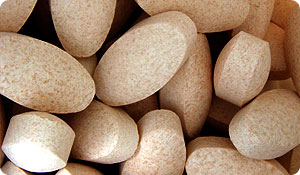
Glucosamine is a naturally-occurring amino acid found in cartilage and other connective tissue in the body. It is one of the most popular dietary supplements used to treat symptoms of osteoarthritis and many patients swear by it. However, according to the National Institutes of Health (NIH), the supplement can increase blood pressure.
Benefits of Glucosamine for Osteoarthritis
Several studies, including the large-scale Glucosamine/chondroitin Arthritis Intervention Trial (GAIT), reveal that glucosamine combined with chondroitin sulphate can significantly relieve pain in patients with moderate to severe pain.
As a result the supplements help to reduce your dependence on non-steroidal drugs, such as ibuprofen. Generally, this is considered a big plus for people with arthritis, because ibuprofen and other pain relievers such as acetaminophen carry serious side effects, including liver damage and stomach upset. But, glucosamine supplements aren't without their risks.
Possible Downside of Glucosamine for Osteoarthritis Treatment
According to the Arthritis Foundation and other sources, intravenous glucosamine causes metabolic insulin resistance and affects how blood vessels function. These two conditions are related to some chronic health conditions, such as diabetes, obesity, cardiovascular disease—and hypertension or high blood pressure.
Granted, some research linking the supplement to these health problems did not focus on oral glucosamine, which is the primary way most people take the supplement. One study that investigated oral glucosamine suggests that short-term use - 500 mg per day for six weeks - does not affect insulin resistance and vascular function. But, it's the long-term effects that are still unclear.
Some users report experiencing elevated triglyceride levels after taking the supplement. While one study disputes this connection, if glucosamine does increase your triglyceride levels, you're more at risk for developing high blood pressure and other cardiovascular diseases.
Furthermore, some glucosamine supplements are made with sodium chloride, thereby increasing your intake of salt—a food that can trigger or worsen high blood pressure.
Safer Ways to Take Glucosamine to Treat Osteoarthritis
• Always speak to your physician first about starting a new drug or supplement. These arthritis medications may interact with each other, or you may have another health problem, including high blood pressure, that makes taking these drugs dangerous.
• Take glucosamine for a short period only. The NIH recommends taking it for only 30 to 90 days.
• Use caution if you have diabetes or hypoglycemia as your blood sugar levels may be affected. Extra blood glucose monitoring may be necessary if you take the supplement.
• Don't mix glucosamine with blood thinning medications such as aspirin, warfarin, or hyptertensive drugs.
• Take vegetarian glucosamine supplements if you're allergic to shellfish, the main source of this dietary supplement.
• Check your triglyceride levels. If you take glucosamine supplements to treat osteoarthritis, you should have your blood lipid levels tested. Keep in mind that osteoarthritis is very common in people who are overweight or obese, who are already more vulnerable to high triglyceride and cholesterol levels, and therefore high blood pressure as well.
Sources:
National Institutes of Health, Arthritis Foundation, Mayo Clinic, Center for Science in the Public Interest, National Center for Complementary and Alternative Medicine
National Center for Complementary and Alternative Medicine primary GAIT press release.
Diabetes, November 2006. Vol. 55 No. 11, pp. 3142-3150. "Oral Glucosamine for 6 Weeks at Standard Doses Does Not Cause or Worsen Insulin Resistance or Endothelial Dysfunction in Lean or Obese Subjects." Michael J. Quon et. al. http://diabetes.diabetesjournals.org/content/55/11/3142.full





